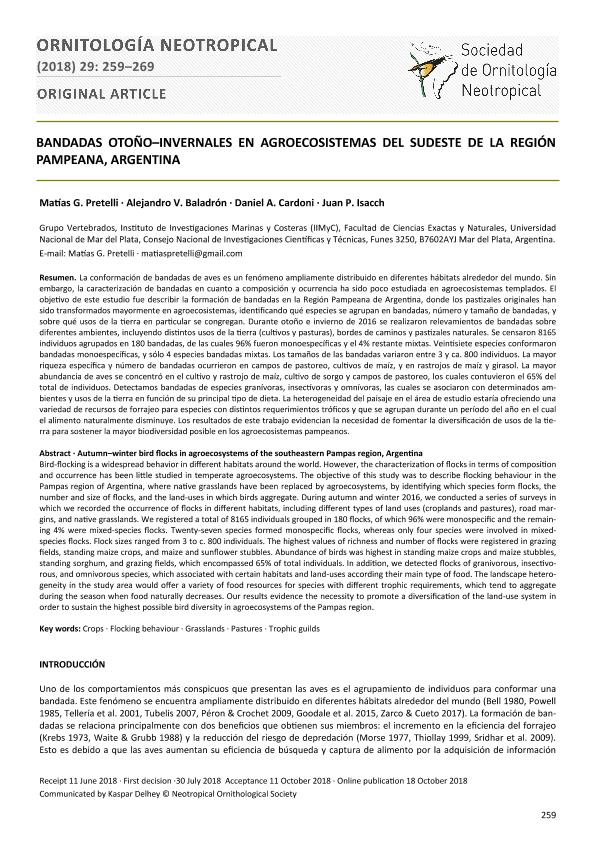Artículo
La conformación de bandadas de aves es un fenómeno ampliamente distribuido en diferentes hábitats alrededor del mundo. Sin embargo, la caracterización de bandadas en cuanto a composición y ocurrencia ha sido poco estudiada en agroecosistemas templados. El objetivo de este estudio fue describir la formación de bandadas en la Región Pampeana de Argentina, donde los pastizales originales han sido transformados mayormente en agroecosistemas, identificando qué especies se agrupan en bandadas, número y tamaño de bandadas, y sobre qué usos de la tierra en particular se congregan. Durante otoño e invierno de 2016 se realizaron relevamientos de bandadas sobre diferentes ambientes, incluyendo distintos usos de la tierra (cultivos y pasturas), bordes de caminos y pastizales naturales. Se censaron 8165 individuos agrupados en 180 bandadas, de las cuales 96% fueron monoespecíficas y el 4% restante mixtas. Veintisiete especies conformaron bandadas monoespecíficas, y sólo 4 especies bandadas mixtas. Los tamaños de las bandadas variaron entre 3 y ca. 800 individuos. La mayor riqueza específica y número de bandadas ocurrieron en campos de pastoreo, cultivos de maíz, y en rastrojos de maíz y girasol. La mayor abundancia de aves se concentró en el cultivo y rastrojo de maíz, cultivo de sorgo y campos de pastoreo, los cuales contuvieron el 65% del total de individuos. Detectamos bandadas de especies granívoras, insectívoras y omnívoras, las cuales se asociaron con determinados ambientes y usos de la tierra en función de su principal tipo de dieta. La heterogeneidad del paisaje en el área de estudio estaría ofreciendo una variedad de recursos de forrajeo para especies con distintos requerimientos tróficos y que se agrupan durante un período del año en el cual el alimento naturalmente disminuye. Los resultados de este trabajo evidencian la necesidad de fomentar la diversificación de usos de la tierrapara sostener la mayor biodiversidad posible en los agroecosistemas pampeanos. Bird-flocking is a widespread behavior in different habitats around the world. However, the characterization of flocks in terms of composition and occurrence has been little studied in temperate agroecosystems. The objective of this study was to describe flocking behaviour in the Pampas region of Argentina, where native grasslands have been replaced by agroecosystems, by identifying which species form flocks, the number and size of flocks, and the land-uses in which birds aggregate. During autumn and winter 2016, we conducted a series of surveys in which we recorded the occurrence of flocks in different habitats, including different types of land uses (croplands and pastures), road mar‐ gins, and native grasslands. We registered a total of 8165 individuals grouped in 180 flocks, of which 96% were monospecific and the remaining 4% were mixed-species flocks. Twenty-seven species formed monospecific flocks, whereas only four species were involved in mixed species flocks. Flock sizes ranged from 3 to c. 800 individuals. The highest values of richness and number of flocks were registered in grazing fields, standing maize crops, and maize and sunflower stubbles. Abundance of birds was highest in standing maize crops and maize stubbles, standing sorghum, and grazing fields, which encompassed 65% of total individuals. In addition, we detected flocks of granivorous, insectivorous, and omnivorous species, which associated with certain habitats and land-uses according their main type of food. The landscape heterogeneity in the study area would offer a variety of food resources for species with different trophic requirements, which tend to aggregate during the season when food naturally decreases. Our results evidence the necessity to promote a diversification of the land-use system in order to sustain the highest possible bird diversity in agroecosystems of the Pampas region.
Bandadas otoño-invernales en agroecosistemas del sudeste de la región Pampeana,Argentina
Título:
Autumn–winter bird flocks in agroecosystems of the southeastern Pampas region, Argentina
Pretelli, Matías Guillermo ; Baladron Felix, Alejandro Victor
; Baladron Felix, Alejandro Victor ; Cardoni, Daniel Augusto
; Cardoni, Daniel Augusto ; Isacch, Juan Pablo
; Isacch, Juan Pablo
 ; Baladron Felix, Alejandro Victor
; Baladron Felix, Alejandro Victor ; Cardoni, Daniel Augusto
; Cardoni, Daniel Augusto ; Isacch, Juan Pablo
; Isacch, Juan Pablo
Fecha de publicación:
12/2018
Editorial:
Neotropical Ornithological Society
Revista:
Ornitología Neotropical
ISSN:
1075-4377
Idioma:
Español
Tipo de recurso:
Artículo publicado
Clasificación temática:
Resumen
Palabras clave:
AVES
,
BANDADAS
,
INVIERNO
,
PAMPAS
Archivos asociados
Licencia
Identificadores
Colecciones
Articulos(IIMYC)
Articulos de INSTITUTO DE INVESTIGACIONES MARINAS Y COSTERAS
Articulos de INSTITUTO DE INVESTIGACIONES MARINAS Y COSTERAS
Citación
Pretelli, Matías Guillermo; Baladron Felix, Alejandro Victor; Cardoni, Daniel Augusto; Isacch, Juan Pablo; Bandadas otoño-invernales en agroecosistemas del sudeste de la región Pampeana,Argentina; Neotropical Ornithological Society; Ornitología Neotropical; 29; 12-2018; 259-269
Compartir



